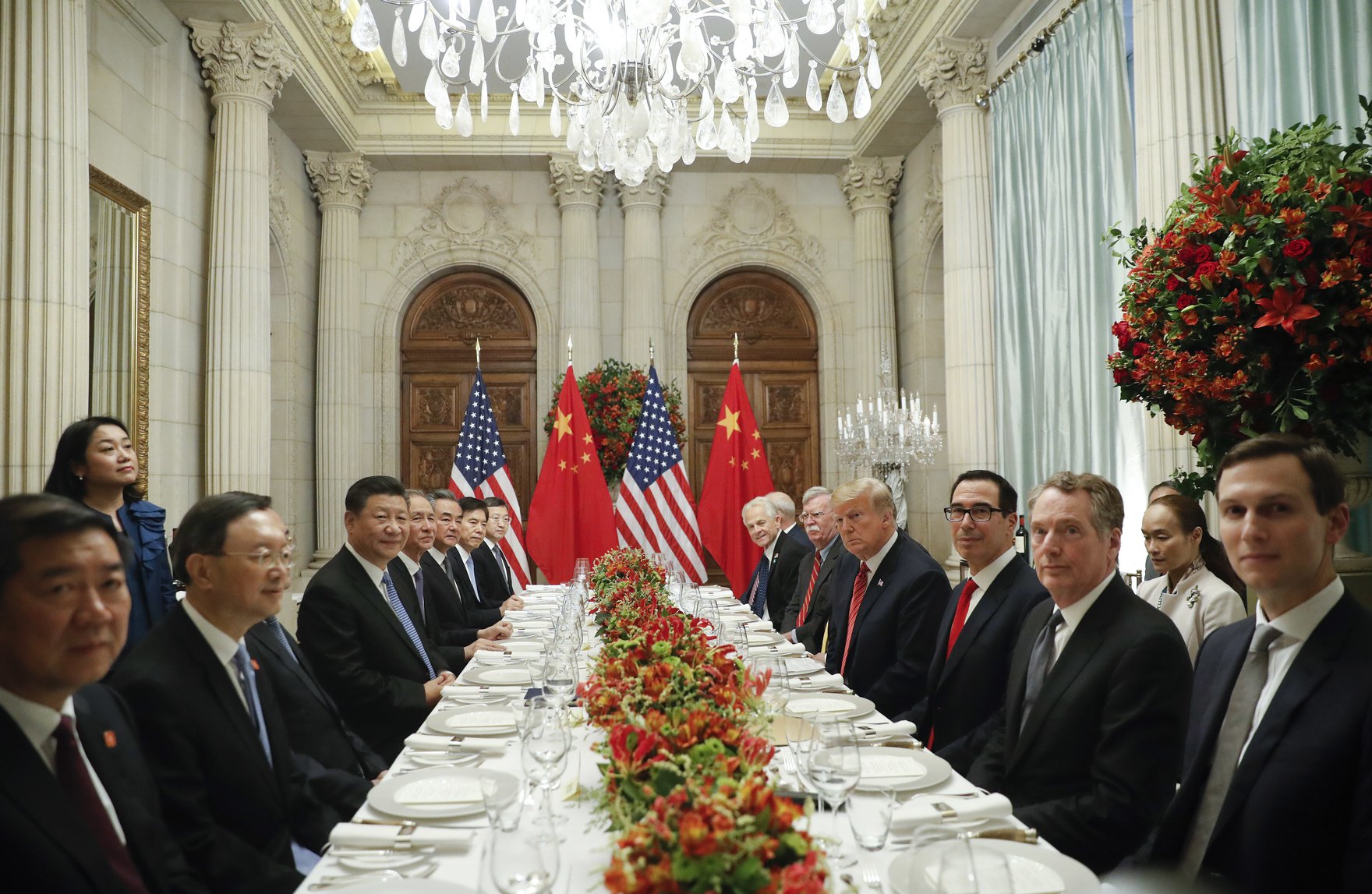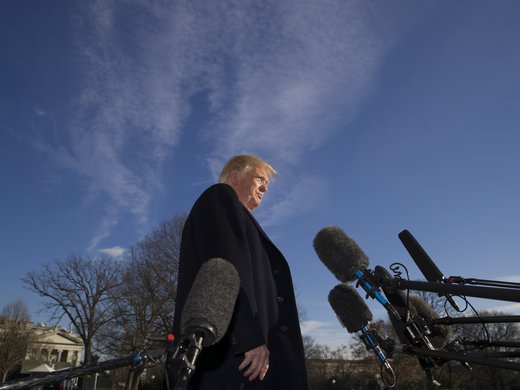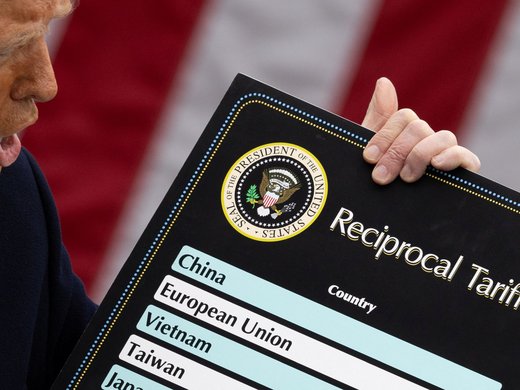The year 2018 saw the outbreak of a rapidly escalating trade war that is global in nature; the commercial relationship between the United States and China is the prime battlefront. It is widely considered to demarcate a profound change in the global economic and political order.
The trade war has many potential roots. Parallels are being drawn between the US-China conflict and the Anglo-German rivalry that led to the breakdown in 1914 of the Concert of Europe. A litany of narrower complaints have been made about the impact of China on the global economy following its accession to the World Trade Organization (WTO).
However, these considerations alone do not provide a fully satisfactory explanation for the Trump administration’s preparedness to shut down trade with China at great cost to its own economy and companies. Something more powerful, however, could be fuelling the trade war: the technological revolution being generated by big data, artificial intelligence and machine learning. These transformative technologies create the grounds for strategic trade and investment policies and open a new theatre for geostrategic rivalry.
This diagnosis is troubling: the year-long tension has been expensive, to say the least, and it is impacting trade, investment, asset values and geopolitics globally. Meanwhile a solution cannot simply focus on ironing out the longer-standing nominal irritants in US-China economic relations. Rather, it must address the elemental forces being unleashed by the technology at the core of this historic trade war — a much more difficult proposition.
The Cost of the Trade War
The measures taken to date have already generated palpable damage to the warring parties and created negative impacts on third parties. A recent paper, “Trade Wars #2018: The Likely Trade and Economic Impact so Far” (written by this article’s author, Mengchun Ouyang and Jingliang Xiao), estimates that the first rounds of tariffs and tit-for-tat retaliation have had a larger relative impact on China than on the United States (about –0.4 percent of GDP compared to about –0.2 percent for the United States; and welfare losses of about US$100 billion for China versus about US$50 billion for the United States). China is also more exposed to US export restrictions since its flagship technology firms (ZTE and Huawei) still rely on critical US technologies; this gives the United States additional leverage to extract concessions from China. These considerations explain China’s eagerness to seek an early truce.
However, if the United States and China continue to escalate the conflict through higher and wider-ranging tariffs and restrictions on American or Chinese firms operating in each other’s markets, the negative impact will likely rise. As the Brexit negotiations have shown, even peaceful divorces are damaging to a deeply integrated global economy. In the event of a total breakdown of trade between the United States and China — the equivalent of a new iron curtain descending across the Pacific — both economies would suffer a negative impact on the order of –2 percent of GDP, and welfare losses on the order of US$400 billion each (these figures are from preliminary unpublished simulations by the author and Xiao).
Quantitative modelling suggests that third parties, including Canada and Korea, benefit from trade diversion, that is, by picking up market shares in the warring parties’ markets at the latter’s expense. However, the flanking measures being adopted aggressively by the United States to prevent China’s indirect market access, together with the general heightened uncertainty for all trading economies, likely create negative impacts that far outweigh any trade diversion benefits.
To date, the global economy has been reasonably resilient. Partly, this reflects the aggressive stimulus measures put in place by the main antagonists. The United States is projected to run a structural fiscal deficit of 5.6 percent of GDP in 2019, and the Trump administration has exerted pressure on the Federal Reserve Board to delay withdrawal of monetary stimulus — policy interest rates in the United States remain negative in real terms at this late stage of the expansion. China, for its part, has announced extraordinary fiscal measures, loosened lending rules for its banking system and allowed its exchange rate to depreciate.
While fiscal and monetary stimulus has helped to offset the negative growth impulse from the trade measures, this amounts to substituting trade uncertainty for prudent fiscal and monetary policy as a means of moderating incipient inflationary pressures. This is likely to create macroeconomic risks and macroeconomic stabilization problems down the line. Such risks to the global economy are signalled by the decline in both the US and Chinese equity markets, and by the decline in foreign direct investment (FDI) into both economies. Given that these two economies were the most popular destinations for FDI in recent decades, the decline in their equity valuations underscores the gravity of the impact on business confidence.
The Cause of the Trade War
Commentary on how the current conflict might be contained so as to limit the damage tends to focus on the bilateral rivalry and, in particular, on the litany of specific grievances put forward by the United States. Some see it as an inevitable geopolitical/geoeconomic rivalry between an established hegemonic power and a rapidly rising potential challenger. Many commentators express disappointment at China’s failure to democratize; this suggests that a contributing factor is the intensification of “system friction” due to China’s non-conformity with Western models of social organization and legal norms, coupled with its sheer size in the trading system. Trade with China is also widely assigned blame for US de-industrialization and related job and income distribution impacts in the US heartland. The particular grievance is unfair trading practices of Chinese state-owned enterprises (SOEs) that allegedly are behind the bilateral China-US goods trade imbalance. And persistent complaints have been made by US intellectual property (IP) rightsholders about weak enforcement of IP rights in China and the impact on their competitive position of China’s indigenous innovation policies.
However, whether any of these individually — or even cumulatively — warrant the scale of response mounted by the Trump administration can be debated. The above litany of potential causes is longstanding and well studied; indeed, there are contrary views on the significance of each. China’s rise has made it, at most, a regional military power and it still lacks most of the trappings of a genuine economic power. Further, China’s trading partners, least of all the United States, have hardly been shy to use remedies available under the WTO to address specific irritants in their trade relations with China and have room to go further. And, China has been rapidly upgrading its domestic system of IP enforcement as it is becoming a major generator of IP itself.
Without necessarily gainsaying these various analyses, one might note that trade war is actually predicted by the emergence of a new technological domain — big data, machine learning and artificial intelligence. Several features of the data-driven economy, in which data is the essential form of capital, conspire to make global rivalry inevitable, both in geoeconomic and geostrategic terms.
As regards the economics, the emerging data-driven economy features large economies of scale and scope, often accompanied by network externalities, and pervasive information asymmetry. These characteristics tend to result in “winner take most” economics, with the prize to the winner being the capture of international rents; these rents promise to be very large and thus serve as an inducement for strategic trade and investment policy. Worldwide, governments are pouring massive sums into development of technology in the digital space to capture these rents.
The economic incentives generated by the data-driven economy are compounded by the military advantage that dominance in data and artificial intelligence promises to generate. The term “cold war” has already come into play as observers draw parallels with the Cold War geostrategic rivalry between the United States and the Soviet Union. The latter conflict played itself out through a series of strategic denials of technology and markets to the opponent, coupled with rivalry to expand spheres of influence, flipping of unfriendly governments, and proxy wars.
Many of the parallels that have already emerged between the US-Soviet Cold War and the current rivalry between the United States and China support technology’s centrality to the conflict. Most notable is the proliferation of measures to deny US technology to Chinese firms: these include adoption of the US Foreign Investment Risk Review Modernization Act (FIRRMA) which greatly expanded review of Chinese investments in the US technology sector; the expansion of the list of Chinese firms on the US export ban of sensitive technology; and a new export ban on Huawei’s US subsidiary. As well, the United States has rolled out strategies to counter China’s Belt and Road initiative and the China-based Asian Infrastructure Investment Bank. Further, a new measure in the Canada-United States-Mexico Agreement, section 32.10, signals risk to partners’ trade with the United States if they enter into trade agreements with China. The United States has indicated that it will make this a standard feature of its trade agreements. This has major implications for the organization of global trade going forward, given the preparation of trade negotiations by the United States with Japan and separately with the European Union.
Potential Responses to a Trade War
This analysis suggests that the United States will consider the WTO a geostrategic liability if China is still at the table. The pre-WTO General Agreement on Tariffs and Trade excluded the Communist bloc and this is the preferred situation to the trade hawks in the Trump administration. The United States has already rejected the European Union’s proposal for WTO reforms. Further, the analysis suggests that the institutional framework that will emerge to frame some semblance of a trade peace will eventually take the form of a new détente between the two economic superpowers. In the meantime, the “open liberal international order” fractures, and third parties find themselves caught in the crossfire.
The global economy is now deeply integrated through value chains that include the top tier powers — the United States and China. Second tier powers — such as Canada and Korea — figure prominently in these production webs; they can take some actions to prevent a great unravelling. Recognizing the technological roots of the current trade conflict, second tier powers need to press for WTO reforms that go to the heart of the technological roots of this trade war rather than on treatment of the symptoms. In my view, doing so requires addressing the following issues through what might be labelled a new “digital round” of WTO negotiations:
Strengthened competition policy measures: Competition policy was a minor, if thorny, issue in the Uruguay Round and was hived off as one of the so-called “Singapore Issues” for later negotiation. Today, in the context of “winner takes most” economics, it is perhaps the most important economic framework issue to be addressed. For example, three prominent issues under the umbrella of competition policy are: competitive neutrality in technology-intensive sectors; competitive access to proprietary data of companies that provide internet platforms; and the need to shift regulatory attention on mergers and acquisition activity to focus more on pre-emptive take-out strategies in which established companies buy out upstart technology firms.
New international conventions on intellectual property: There is a plethora of issues raised by innovation in the data-driven economy to be addressed, including ownership of intellectual property created by artificial intelligence and machine learning; shortened protection terms, given the acceleration of innovation; transparency rules related to secrecy of algorithms; and conditions of access to proprietary data.
New conventions for rules on flow of data across borders: These rules must reconcile the need to have free flow of data for commercial services (consistent with the WTO General Agreement on Trade in Services) with the need for fair international sharing of the asset value of data generated by nations. Further, rules should support full security for data as infrastructure of the digitized economy; establish protocols for use of data to protect sovereignty (for example, where data is deployed for manipulation of elections and the manufacturing of populism); and set norms to limit state surveillance and so-called “surveillance capitalism.”
Reframed disciplines on subsidies and the economic role of the state: Huge investments are being underwritten by the state under alternative models of state support — specifically, state-owned or state-directed enterprises (the Chinese model) and state-fed enterprises (the American model). Given the potential for market failure in the data-driven economy, such investments make sense at a transformative moment of economic evolution. There is a much greater need for industrial policy space in this emerging economy, which also demands a rethinking of existing norms and the WTO rules that restrict such policies.
An updated Agreement on Trade-Related Investment Measures (TRIMS): The new TRIMS should, among other things, distinguish between private investment and state investment; recognize that FDI into the knowledge-based economy aims to extract knowledge assets rather than introduce them; recognize the anti-competitive nature of foreign acquisitions of young technology firms by cash-flush tech giants aiming to prevent the emergence of future competition; and provide for policy leeway for developing countries. It should also broker competitive access to the build-out of the digital infrastructure (5G networks, in particular, where the alleged national security grounds are being used to exclude China’s participation without adjudication), such that third countries are not caught in the vise of a US-China rivalry.
These negotiations could be organized as a new “digital round,” premised on the understanding that it is better to search for a global digital realm and to establish mutual accommodation through negotiation rather than through the blunt and destructive force of trade wars. Their objective would be to create a world in which all countries have a mutual stake in ensuring its integrity — rather than a digital economy framework of what might be termed “Digitalpolitik” (coined for the digital version of realpolitik), featuring walled-off and warring realms subject to mutual routine attack, with ruinous prospects for all.





